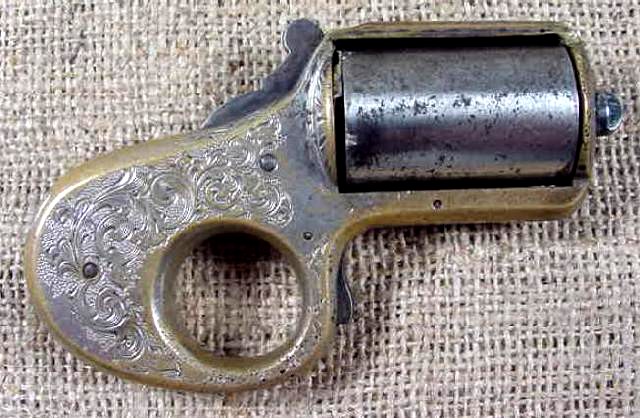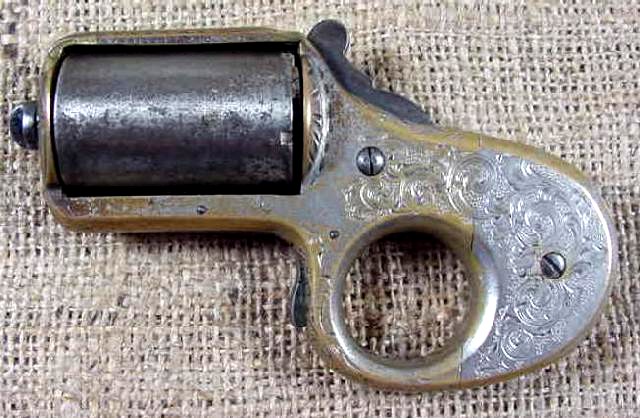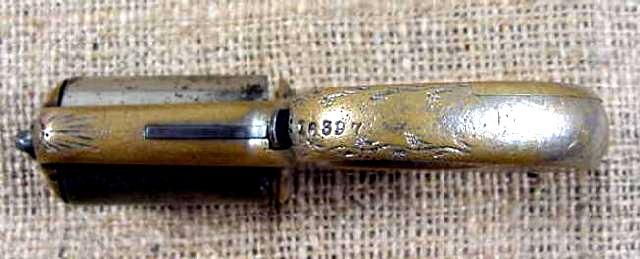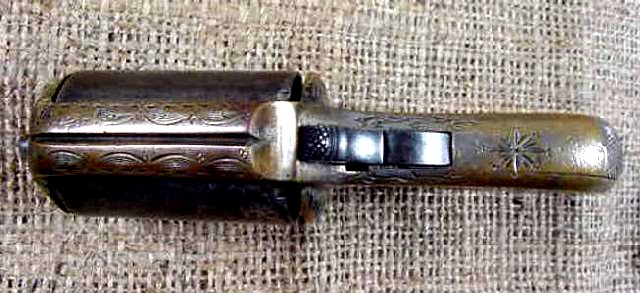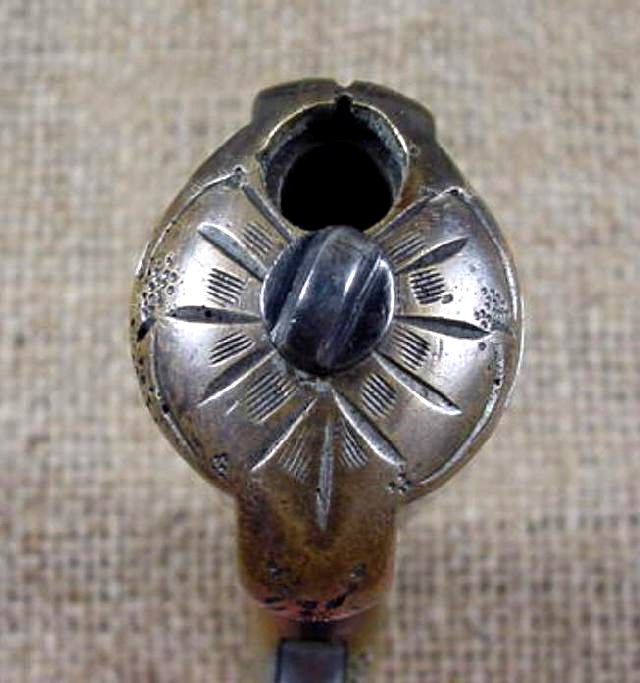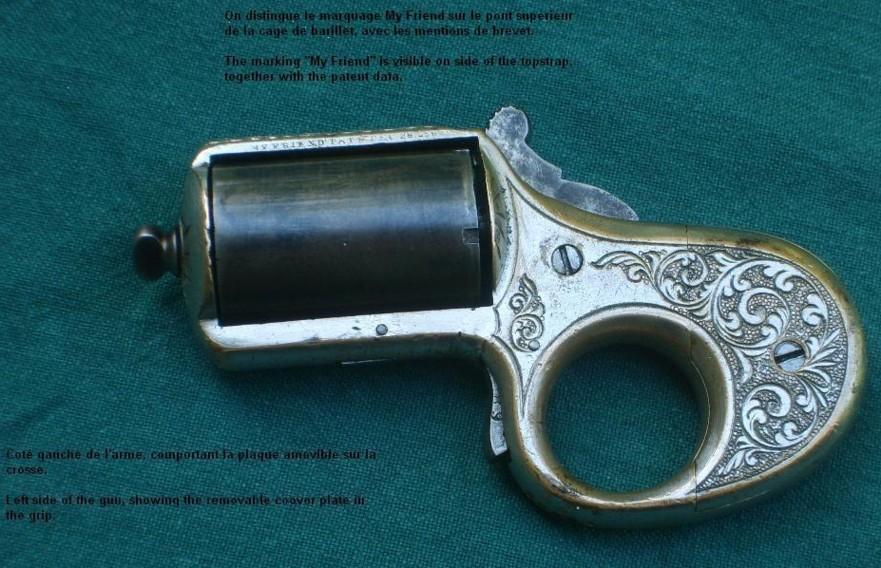
JAMES REID
THE JAMES REID "MY FRIEND" PEPPERBOX, a.k.a. " Knuckleduster"
It seemed interesting to me to have a closer look at one of the most uncommon pocket weapons of the American Old West.
Although basically in all respects a pepperbox, its orthopaedic concept makes it an unicum among all others, and that alone is a good reason for a close examination.
THE INVENTOR
However but few information have survived about that period, we know that James Reid was born in 1827 in Belfast, Ireland. He started his apprenticeship as a gunmaker there, and moved later to Glasgow, Scotland, where he lived until the age of 30.
Attracted like many others by the promises of the New World, he immigrated to America in 1857 and settled in New-York with his family. There he started his own business, which in 1862 was recensed as the "James Reid Manufactory" in the city directories. This manufactory is supposed to have produced not only guns, but also various tools and machinery accessories.
From 1863 on, however, the company is recensed as "pistolmaker".
The very first gun made by James Reid seems to be the so-called "Breech-Loading SS Pistol" in .28 calibre with removable breech. For a long time, this unmarked pistol was believed to haven been invented by Rollin White and produced by Lowell or the Mass Arms Co, until recently one sole specimen surfaced which bears the name of James Reid, New-York.
Total production of this pistol is believed less than hundred (ca. 1861-62). See Flayderman ref 7C-038.
In the year 1861, James Reid issued his first cartridge revolver in .22 calibre, and short thereafter he issued the same model in .32 calibre. An example of this early model is shown on another page (revolver with a curious loading gate).
Probably in the same period, Reid issued the small derringer pistols marked W. Irving, who was a gun dealer located 20, Cliff Street, New-York City, the same address Reid was using to promote his weapons.
In 1862, business was running good and Reid's shop is providing employment to 10 people. Wit a view to avoiding lawsuits and other problems for infringements on the Rollin White patent, he devised a special dual-ignition cartridge for his revolvers that was patented in April, 1863. Production of his revolvers started in 1863 and ran trough 1865.
The Civil War created a large demand for personal handguns, and Reid is believed to have curtailed his production to fill up an order of W.W. Marston covering about 2,000 .31 percussion revolvers. These guns also bear the W. Irving address, which seems to indicate that Irving was an agent for both makers.
Due to illness in his family, Reid was forced to move from New-York in 1865. He settled in the city of Catskill, north of New-York in the Catskill Moutains. There he relocated his manufactory, but from 1865 to 1868 his main activity seems to have been the operation of a grint mill, which he continued simultaneously with his gun production.
Prior to leaving New-York in 1865 however, Reid had already produced a few prototypes of his famous "knuckleduster" pepperbox. He resumed his gunmaking activity with the development of that little pocket arm, that soon became successful enough to provide employment to 12 people. The gun was granted a patent on December 26, 1865.
Unfortunately, like many others, Reid's business suffered from the severe economic depression in the USA between 1873 and 1880. His business employment was soon reduced to his 3 sons and one apprentice. Hard competition and the introduction of double-action revolvers made it quite hard to keep on business. In an attempt to keep a part of the market, he issued between 1876 and 1883 six new models, but sales could barely keep the company alive. The production was ceased and the factory was closed in 1883.
Reid the moved to the near city of West Troy, NY, where he was employed as a machinist. He died in 1898.
THE KNUCKLEDUSTER
Nomenclature
The name "knuckleduster" was given by 20th-century collectors. In his catalogues, Reid refers to it as "knuckler" or more often "My Friend". The origin of the latter is totally unknown, and any attempt to explain why Reid chose that name for his guns would be purely speculative.
Description
Basically a 7 or 5 shot pepperbox, issued in the 3 following calibres:
- .22 short, the most popular one, 7-shot, about 20,000 made
- .32 short RF (the one presented in this article), 5-shot, about 3,100 made, thus 7 times scarcer than the .22
- .41 short RF, 5-shot, very scarce since the total production is believed not to have excesses 150.
All barrels are rifled 4 clockwise.
The 170 first .22 featured an iron frame, a safety device at the bottom of it, and a small trapdoor in the butt, allowing access to the main spring for tension adjustments. That system was soon dropped on the two small calibres, and production went on with brass frames for all three. However, the safety device and the trapdoor remained standard on the 41 calibre guns, which were only made with brass frames.
The guns are all-metal and standard factory hand-engraved. Brass frames are silver plated with blued screws and cylinder. Hammer, cylinder pin and trigger are case-colour. Iron frames were blued.
All cylinders are round. The cylinder pin has a key-shaped head that allows easy unscrewing. The pin is used for extraction of the empty shells.
The standard model has a removable cover plate located at the left side of the grip that provides easy access to the lock mechanism. The latter is very classical, as it is similar to that of the most spur-triggered single action revolvers of the time. On the specimen presented here, the mainspring is evidently a replacement. The spring is hold in place between two raised catches in the bottom of the frame and engages a notch in the rear of the hammer at the upper side.
The hammer has no half-cocked notch.
The most remarkable feature of this weapon, however, is the shape of its grip. James Reid wanted to develop a pocket gun that could also be used as a set of knuckles for hand fighting. The result was this unique shape with the central ringhole in the middle of the grip. The gun is very compact and can easily be hidden in a vest pocket.
Although not ideal, the prehension is however amazingly better than on most pocket revolvers and pistols of the time, which for esthetical reason invariably present grips that are much too short. Reid adopted a total new orthopaedic concept and created a pocket gun that became popular and reached respectable production for a civilian pocket weapon.
The gun is attractive and easy to conceal, witch added to its success among gamblers and whores, but also among urban people who wanted a personal protection but were reluctant to carry a heavy revolver.
Later on, the My Friend knuckleduster was available on request equipped with a barrel like a true revolver. Other models were also proposed, but none of them ever reached popularity comparable to the My Friend.
Aberration
The My Friend pepperbox shows another bizarre feature.
On the right side of the frame is a loading groove and a cut in the recoil shield, both obviously intended for breech-loading.
However, since the hammer has no halfcock notch to allow free rotation of the cylinder, loading this weapon from behind becomes a difficult and dangerous operation.
On the other hand, the cylinder pin, which also acts as an extractor, is easy to unscrew; and once the pin removed, the cylinder falls automatically out of the frame.
Moreover, apart from the firing gate, there is no aperture in the front shield that could allow use of the pin to push de empty cases out with the cylinder held in place.
So, the gun can be loaded from behind, but difficult and at great risks, but the user always has to disassemble the cylinder to remove the empty cases. It seems more logical and easier, once the empty shells have been removed, to reload the cylinder prior to put it in place again.
Thus this breech-loading provision is aberrant, which in production terms means a useless hence costly tooling operation that could easily be avoided.
Serial numbering
Serial numbering on Reid guns is also uncommon in that sense that it began with n° 1 on his first revolver and was carried through in one consecutive series through all the subsequent models, which explains the curiously high numbers on some models of which but a few hundreds have been made.
As far as I know, the James Reid "My Friend" pepperboxes were never copied. They are a remarkable part the legend of the Old American West, being one of the most uncommon fire weapons of the time.
Besides, their relative scarcity makes them a desirable item for today's collectors.
Marcel


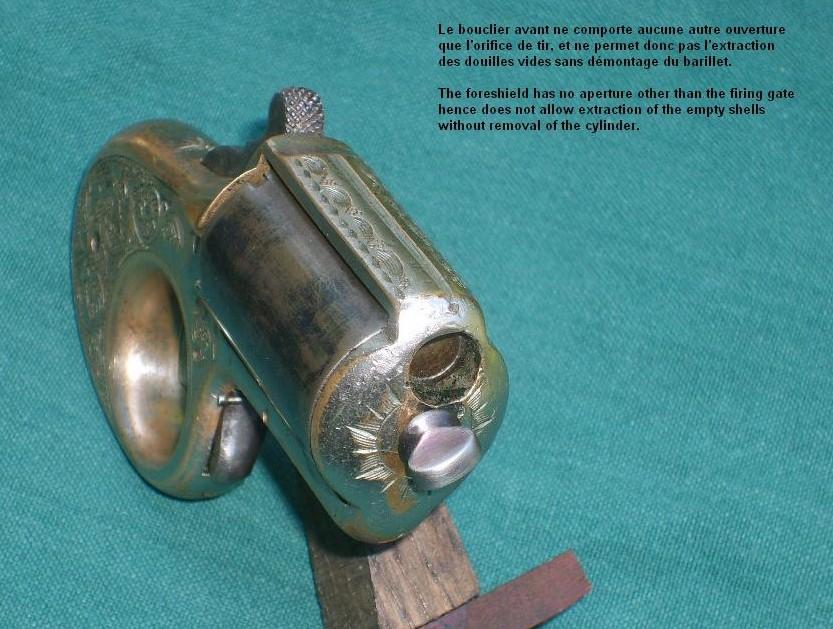
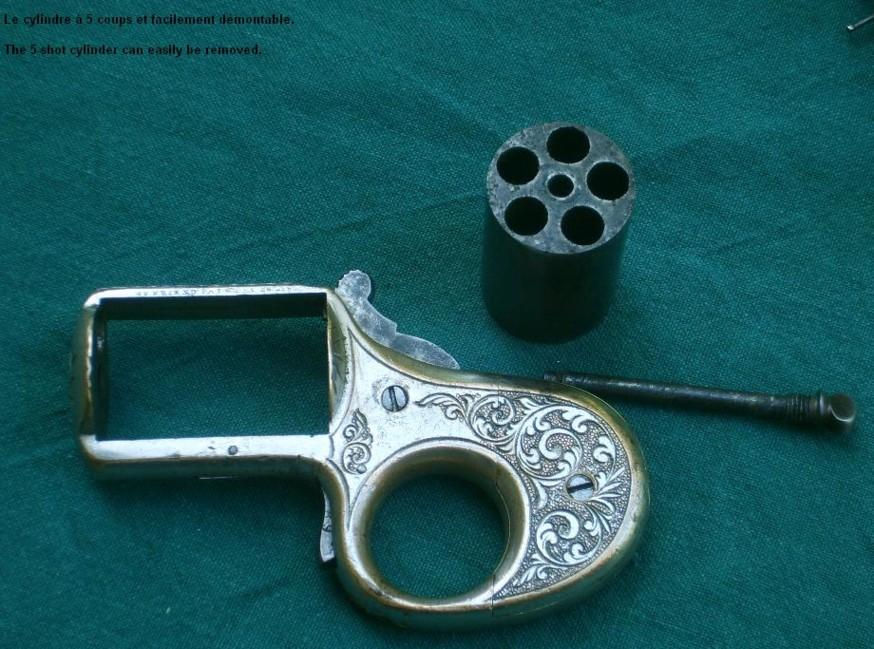
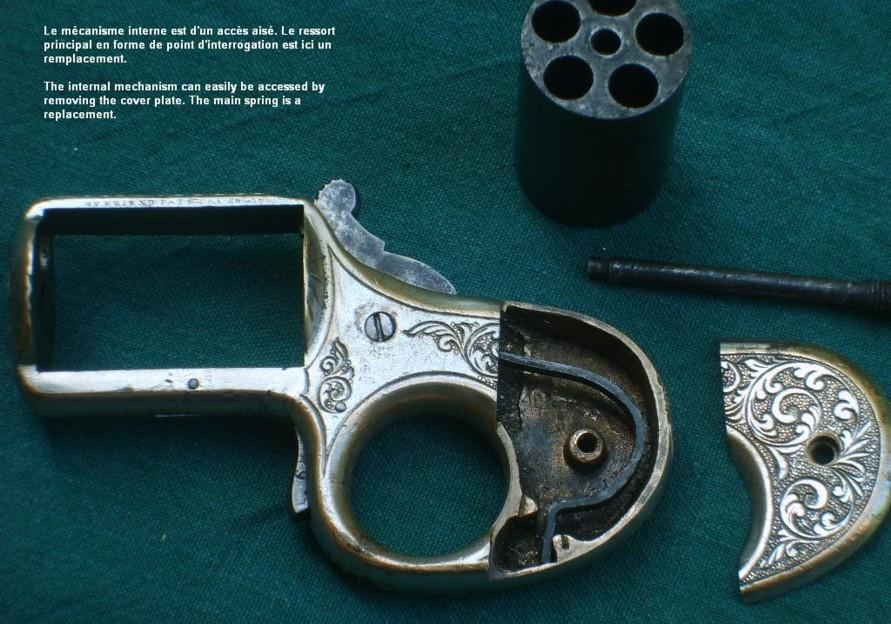
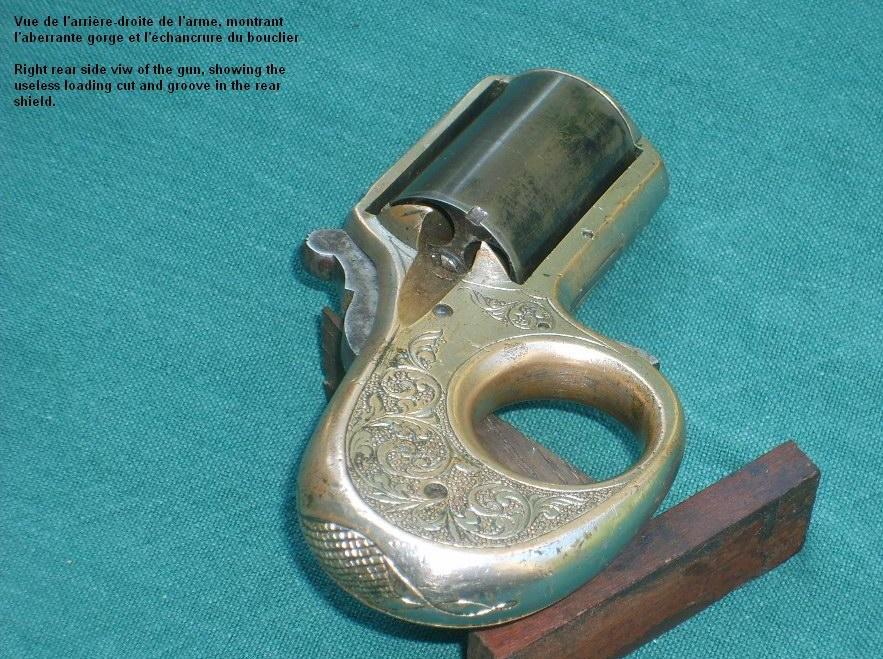
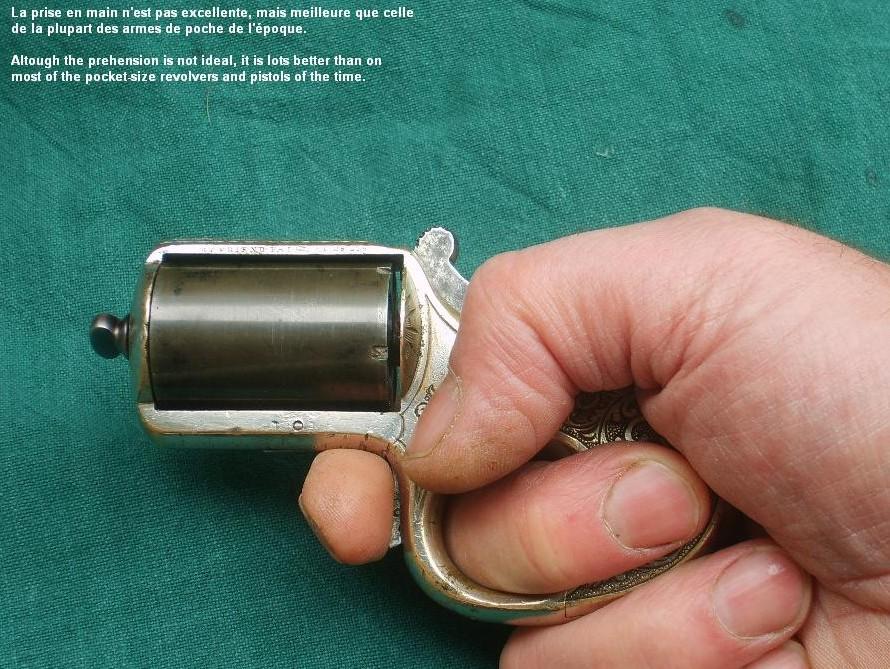
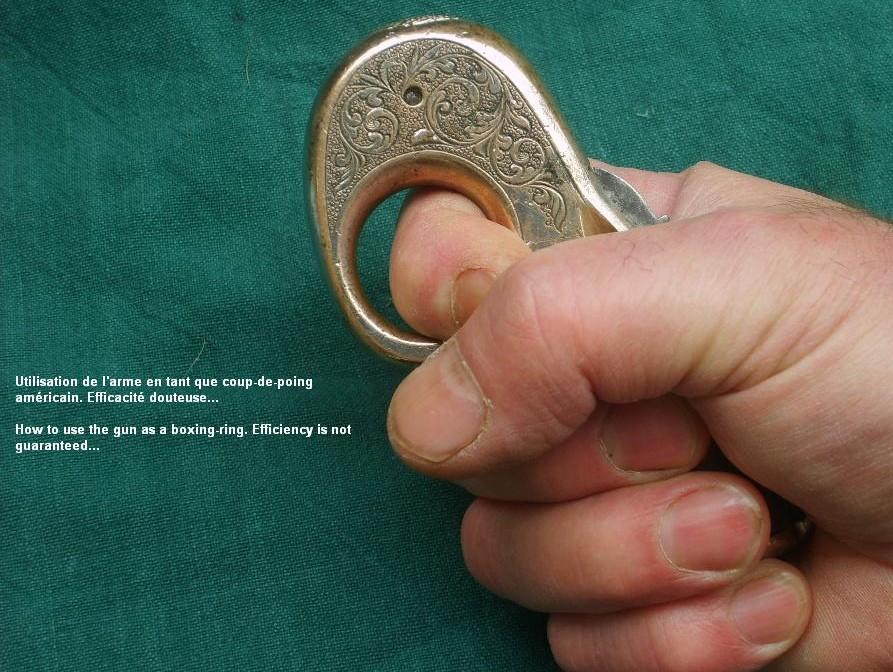
James Reid
cal .32
James Reid .32 cal. Knuckle-Duster in rare .32 cal. rimfire. Circa 1870-1882 with a total quantity mfg. estimated at 3,100.
Marked MY FRIEND PATD. DEC 26, 1865 on topstrap.
This rare gun retains 60-70% original silver plating and is factory engraved.
